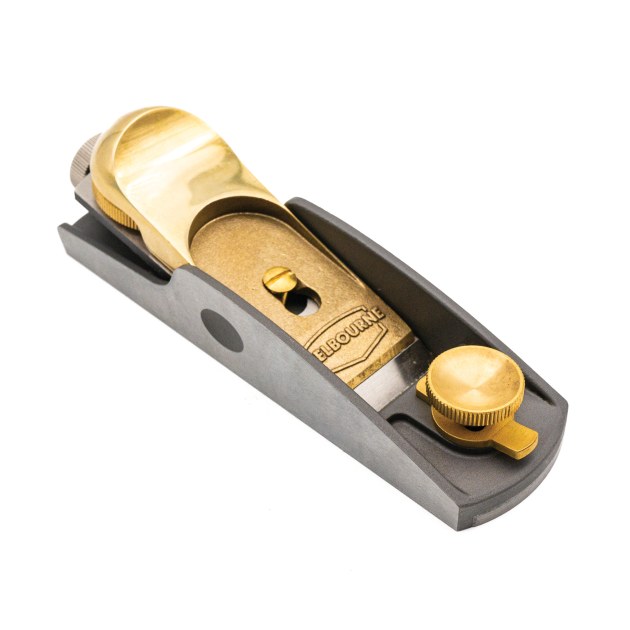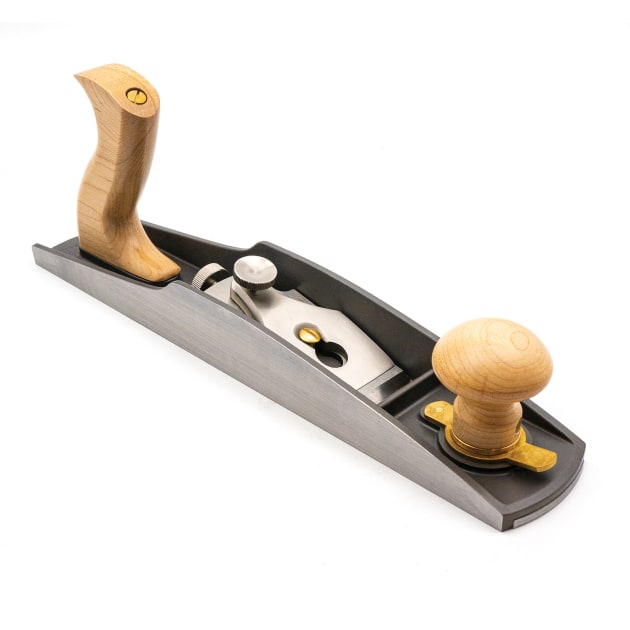TESTED: Melbourne Tool Company Handplanes
Review: Robert Howard
Low Angle Block Plane
The recently formed Melbourne tool Company has just entered the highly competitive field of handplane manufacturing. Their tools are designed in Melbourne, but made in China. Once this may have caused alarm, but most people know many excellent products are now made there.
My first impression of the low angle block plane is that it is beautifully made. The body casting appears excellent, very clean with finely ground sole and sides. The front, adjustable shoe is a bit sloppier in fit than the more expensive competition, but this is a cosmetic difference that does not affect performance. It also seems to have been ground separately from the body,
so it is not quite level with the rest of the sole, but it is close enough to allow very fine shavings to be taken. I am a fan of the differential thread depth adjusters found on the Veritas planes, and was initially pleased to see them employed here. The two threads would benefit from some finessing however, to reduce the almost full turn of backlash closer to the one-eighth turn on my Veritas planes.
A more fundamental problem is the combination of two right hand threads, which results in a net movement determined by the difference between the two pitches. This facilitates very fine adjustment of the depth of cut. Veritas chose a left and right hand combination so the pitches added to give rapid movement. This can be justified on low angle planes because, with a 12° bed, the blade has to move much further than one bedded at 45° to achieve the same change in depth of cut.
But this isn’t the main problem. As nearly as I can measure, the two pitches chosen are a large 1.5mm and a smaller 0.8mm (or 17TPI and 32TPI). In other words, a full turn of the depth adjuster effectively moves the blade forward 1.5mm (in the rear nut), back 0.8mm (in the front nut), for a net movement forward 0.7mm.
My question is, why not just use a single 0.7mm thread, and eliminate the extra manufacturing associated with the complex differential thread mechanism? I think the point of using the differential thread system is to achieve a result that cannot be achieved with a single thread, because either the thread required would be too coarse for the diameter
of the adjuster shaft, or too fine to cut accurately or easily.
The supplied high speed steel blade sharpened quite easily, but was just a little off being exactly square. It was the same after sharpening, but so close that it normally would not be a problem, as it could be corrected using the lateral adjustment mechanism. Ironically, the precision of the body casting was so good that there was not enough lateral adjustment possible to correct even this small error, so care needs to be taken to sharpen the blade square.
Another concern is the cap iron. This has a very sleek profile which might look good, but compromises its resistance to bending. This is very apparent when the blade is locked down because, unlike my other block planes, there is no discernible point where the feedback says the blade is locked. I wasn’t game to keep turning the locking wheel until it felt like the locked position. Many users will be used to the feel of that locked position, and, without thinking, overtighten the blade and possibly damage the cap iron. MTC do explicitly caution against this in their online instructions, but I wouldn’t bet on that working well.
Finally, in another strategic choice, the Lie-Nielsen design of the spinner locking wheel has been chosen, rather than, say the Veritas. I have fitted all my L-N planes with Veritas wheels because I believe these produce less friction and allow easier depth and lateral adjustment.
The price of this plane ($185 at time of writing) is a huge argument in its favour, and you do get a lot for the money. It really is a beautifully made, well presented tool. None of the issues mentioned need be deal breakers, as they mostly reflect strategic design decisions which we are all free to agree or not agree with. They are not manufacturing faults, and I can’t emphasise that enough.
I certainly encourage everyone looking for a good block plane to seriously consider this one.
Low Angle Jack Plane
The low angle jack plane is a very useful plane, although probably not for the reason it was originally made. To understand the original intention, take a 150mm or 300mm steel rule and pretend it is the plane blade. Hold it at 45° to the bench and push the end into some resistance to imitate a pretend piece of wood. The rule will immediately and easily deflect. Now do the same at 12° and you will find it much more difficult to make it deflect.
The planing forces with endgrain, where these planes were originally intended to be used, are many times higher than for long grain, and therefore, with normal 45° bench planes, much more likely to cause blade chatter. The low angle configuration could effectively counter this with a normal thickness blade.
Most new, modern planes do not face this problem as they feature much thicker blades which resist chatter at any angle. This has led to the ironic situation where one convenient use of the low angle plane is as a high angle plane. The ‘low angle’ description is misleading, because it only refers to the bed angle, and not the final cutting angle. Because the blade is held with the bevel facing up, unlike the bevel down position of the normal bench planes, the final angle is the sum of the 12° bed angle and whatever angle the blade is sharpened at. For a normal 35° honing angle (better for hard Australian woods) the blade will enter the wood at 47° – hardly what you would call a low angle. Planing at high angles can be a very effective method of reducing tear-out when you are forced to plane against the grain.
With most Australian woods commonly presenting with interlocked grain, planing these woods against the grain is almost unavoidable. In recognition of this, MTC offer their low angle planes with three blades ground to 25, 38 and 50°. The M2 high speed steel used claims to offer superior abrasion resistance. I didn’t find the blade any more difficult to sharpen, however a good diamond stone would be useful for removing any nicks, or for any initial reshaping work.
The jack is beautifully presented and with its sleek shape and maple front knob and rear tote, it looks like a well made, serious plane that would sit comfortably beside its competition. It has the same differential thread depth adjuster as the low angle block plane, with a similar three-quarter turn of backlash.
It is also set up so the adjustment is the result of the difference in the movements due to the two thread pitches, so it is designed for fine, rather than quick adjustment. Whether this is appropriate is up to you, but bear in mind low angle blades have to move much further than 45° bench plane blades for the same adjustment in depth of cut. I would also prefer a larger knob on the adjuster to make it easier to use, but that is a minor point.
The cap iron is made of steel, and so does not suffer the deflection issues of the block plane. The feedback makes it very easy to know when the blade is locked down.
My only criticism of this plane revolves around the blade. It has ample room for any required lateral adjustment, which
is good, however unlike the block plane blade it has even striations running down its length. When I first saw them I thought I was sharpening a toothing blade. The marks were deep enough to feel with a fingernail, and took a while to remove. I put this down to a production glitch that snuck through the quality control. It was not readily apparent until I began the sharpening process, and hopefully will be easily fixed.
This is an excellent plane for the price ($349 at time of writing), and well worth your consideration.
Review tools from Melbourne Tool Company, see www.melbournetool.com
Robert Howard is a woodworker and sculptor who lives in Brisbane. He teaches woodcarving classes from his studio. See www.roberthoward.com.au




